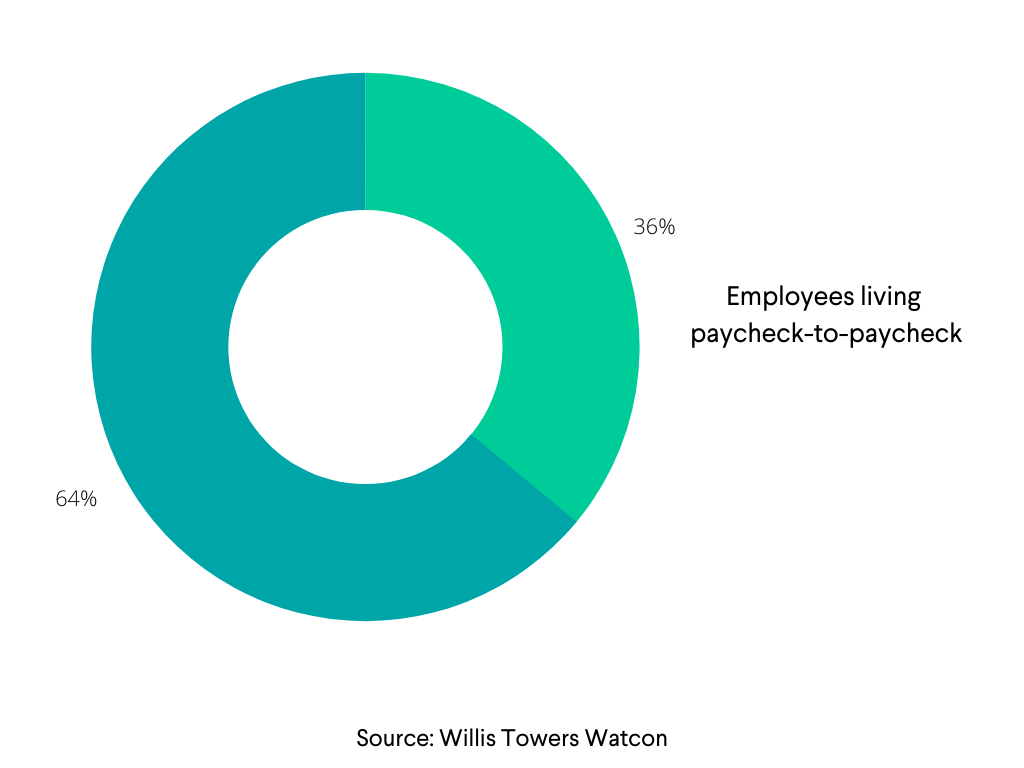Chances are, your employees are stressed. In a 2020 survey on stress in America, overall scores went up for the first time since the survey began in 2007.
Addressing employee stress is a priority for employers – 75% of employers cite employee stress as a top health concern. And while many stressors are outside of the control of the human resources department – a global pandemic comes to mind, for example – there are still many ways HR teams can use employee benefits to address top stressors, from health issues to financial challenges.
The result? When employees feel that their mental health is taken care of, they show twenty percent higher work engagement, less employee burnout, and fewer days lost to absenteeism. As you plan your benefits strategy, consider how enhancing or promoting these seven employee benefits could help your employees feel more supported.
How to support stressed employees through employee benefits
The stressor: General workplace stress
What helps? Fitness programs encourage physical activity
When most people think of regular exercise, they associate it with weight loss or building muscle. But stress relief is one of the most important benefits of regular exercise. Whether your company offers a gym benefit, virtual memberships with online programs, or another incentive to move, consider including stress reduction as a reason to sign up.
Regular exercise also supports healthy sleep. One study found that employees who get enough exercise and sleep are more likely to leave work stress behind when they finish their workday. A fitness benefit, especially including a wearable device, can help your employees reach their exercise and sleep goals for less stress.
The stressor: Workplace stress as well as family issues and mental health challenges
What helps? Employee Assistance Programs, telehealth, and digital solutions can all be beneficial – help your employees understand which is right for them
During the COVID-19 pandemic, 91% of employees said they experienced at least some anxiety, 55% of which experienced moderate or high anxiety levels.
Employers have long had some resources in place to support employees dealing with mental health challenges – 91% of employers already offered an Employee Assistance Program (EAP) before the pandemic started.
But EAP utilization has traditionally been a challenge. Stigma is an issue, as well as confusion around who qualifies for an EAP, and when to use it. If your company offers other mental health resources in addition to your EAP, such as teletherapy, employees may be unsure of which is the best solution for them.
To help, 57% of companies are increasing employee communication about EAP offerings, and 25.4% are expanding their offerings. Make sure to provide clear instructions on how to sign up, who qualifies, and what challenges each solution can help address.

The stressor: Chronic musculoskeletal pain
What helps? Provide a psychologically-informed solution to break the cycle between stress and worsened symptoms
Stress is detrimental to anyone’s health, but those living with conditions like chronic musculoskeletal (MSK) pain, it can make symptoms even worse.
Research shows that stress can both worsen and cause chronic MSK pain – and workplace stress in particular is associated with higher instances of chronic pain. For those already living with conditions like chronic pain, ongoing stress can make symptoms worse.
At Fern Health, we know that addressing the underlying source of chronic pain, such as stress, is just as important as managing pain symptoms. Through our multimodal digital program, Fern Health identifies and addresses the underlying source of chronic pain, such as stress, depression, anxiety, lack of sleep, and other contributors.
Choosing a digital musculoskeletal program is beneficial for supporting remote work wellness, as remote employees may struggle with worse ergonomics at home and lack of access to nearby care.
The stressor: Physical stress
What helps? Better ergonomics, including desk or workspace setup and lighting
Stress isn’t just mental – it can also be physical. Poor office layouts, overly harsh lighting, noise, and poor ergonomics can all lead to physical stress.
Remote workers aren’t immune to physical stress, either. During COVID-19, many employees new to remote work improvised desks out of kitchen tables and couches – and a spike in musculoskeletal pain complaints followed. To help, employers can provide guidance and support for creating ergonomic workspaces at home. Provide a budget for ergonomic chairs and desks, and provide tips on screen placement and lighting to improve back and joint health as well as eye health.
The stressor: Financial worries, such as debt and lack of retirement planning
What helps? Student loan repayment programs, financial wellness programs, and access to affordable healthcare
When employees are experiencing financial stress, research shows that they’re less engaged in their work and more likely to call in sick or come in late. And financial struggles are widespread. Thirty-six percent of employees live paycheck to paycheck, according to a Global Benefits Survey from Willis Towers Watson. Thirty-one percent say that they have financial problems that are negatively impacting their lives.

Even those who feel more financially stable overall still struggle with saving enough for retirement (68%). Fifty-nine percent of respondents said they feel their generation is likely to be much worse off in retirement than their parents’ generation.
Financial stress also impacts health. Nearly a third of Americans have put off medical care because of financial worries. Research has also shown a link between ongoing stress about money has also been linked to migraines, heart disease, diabetes, sleep problems, and other health issues.
Helping employees address their financial woes can also help improve their mental and physical health. For example, student loan repayment helps address a common source of stress, especially for younger workers. Financial wellness programs are also beneficial for anyone struggling with money challenges, including debt reduction, saving for retirement, and financing a home.
Finally, a robust wellness plan that includes low-cost or free options for addressing common conditions helps employees avoid the stress of unmanageable medical bills.
The stressor: General stress, and worries about furry friends
What helps? Offering pet insurance – and after the pandemic, pet-friendly offices – are two solutions that lower stress and boost in-office morale.
Did you know that two-thirds of millennials have a pet? And half report that they’re more likely to stay at a company that allows them to bring their pet to work.
Even for those who don’t have pets, dog friendly offices can help lower stress – as long as none of your employees are allergic to dog fur, of course. Spending time with pets has been shown to decrease levels of the stress hormone cortisol, and lower blood pressure. A 2017 survey found that allowing pets in the office decreased stress levels and increased morale.

A less stressed 2021
A benefits communication strategy that emphasizes the stress-relieving benefits of various programs can help improve employee uptake. Making sure employees understand the costs involved with each program and who can take part also helps them feel confident that taking part in an employee benefit won’t increase any financial stress they may be experiencing.
Ready to provide your employees with a digital musculoskeletal pain program that addresses both the psychological and physical sides of chronic pain? Get in touch with our team using the form below.






